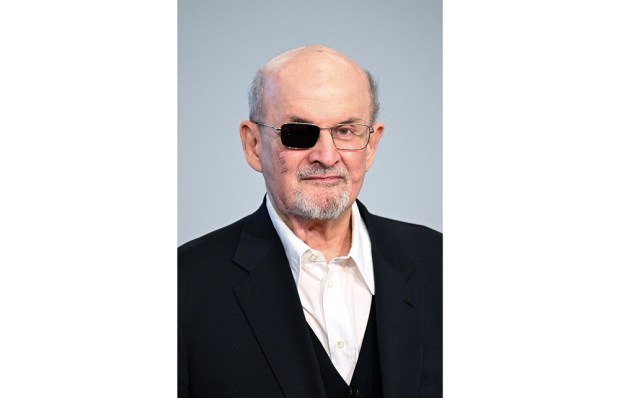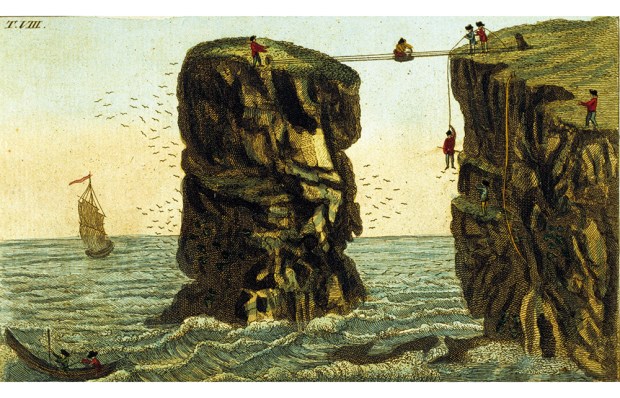On Easter Monday 2018, Donald and Melania Trump stood on the balcony of the White House next to a giant bunny. It’s part of the job: since 1878, presidents have hosted a children’s Easter egg hunt on the south lawn. Usually they rhapsodise abut what fun the kids are going to have. Trump, true to form, told his young guests to ‘just think of 700 billion dollars, because that’s all going into our military this year’. And he also said that the White House was an amazing place, in ‘tip-top shape’.
The liberal media rolled their eyes about Trump boasting to children about military spending but quickly moved on. The fools! They’d just missed the biggest story since 9/11. The President of the United States had confirmed the existence of an international cabal of child-trafficking psychopaths including Hillary Clinton, George Soros, George W. Bush, Barack Obama, Queen Elizabeth II, Bill Gates and Tom Hanks. And one day soon he was going to save the world by killing them all.
The media didn’t know they’d missed the scoop — but they were supposed to miss it. That’s why Trump spoke in code words. Those words were ‘tip’ and ‘top’. Three months earlier, there had been a message from the anonymous intelligence officer who was posting cryptic communications about this cabal to the world on the website 4chan. He called himself ‘Q’ — hence the name ‘QAnon’ to describe both his conspiracy theory and its adherents. In January 2018, Q promised that the President would confirm the truth of the claims by saying ‘tip-top’ in public. Now he had, and from the balcony of the White House. Not only was the building in tip-top shape but, Trump added, ‘sometimes we call it tippy-top shape’.
In the comments under the video of the speech on YouTube there’s predictable mockery of the bloviating President and his frozen-faced spouse. ‘Has he had a concussion or is he just getting dumber?’… ‘Melania looking as evil as ever, dogging everyone beneath her’… ‘The Easter Bunny looked like he just wanted to jump off the balcony and end it all.’
But the ridicule keeps getting interrupted by bursts of jubilation. ‘Tip top. Nuff said. Message received. God is good.’ ‘It’s awesome that he said “tippy top”! 4chan Autists Rock!’ ‘Tippy-Top Shape. WWG1WGA.’ As Mike Rothschild explains in his fascinating book The Storm is Upon Us, some QAnon enthusiasts like to be known as ‘Autists’, because they reckon they possess the freakish cognitive skills of high-functioning autism. And WWG1WGA stands for ‘Where We Go One, We Go All’, one of Q’s superhero-style slogans. Q apparently thought it was painted on the side of a boat belonging to JFK who, according to QAnon, was the last president before Trump not to be part of the paedophile, drug-peddling, terrorist-sponsoring conspiracy.
In fact, the motto was invented for a boat in a 1976 Jeff Bridges movie, a still from which is ‘widely circulated as evidence of JFK’s connection to Q’, according to Mia Bloom and Sophia Moskalenko in their rival book about QAnon, Pastels and Pedophiles. But that’s conspiracy theorists for you: they’re not into fact-checking as we know it, preferring instead to uncover ‘facts’ that ‘check out’ whatever they already believe. Mind you, Bloom and Moskalenko aren’t great fact-checkers themselves: they tell us that Trump ‘called the Easter Bunny “Tippy Top”’, which he didn’t, and when they list countries with QAnon Facebook pages, Wales and the UK appear separately. They also repeatedly struggle with basic grammar and punctuation, which is unfortunate if you can’t hide your disdain for uneducated rednecks.
Both books have a hard time explaining the genesis of QAnon, but that’s understandable. The identity of the original Q remains a mystery, but it’s a rather boring one, since all the likely candidates are dreary fanatics or conmen. The more interesting question is why Q’s ‘drops’ provided such a surge of excitement for millions of Trump supporters. Bloom and Moskalenko really go to town on the issue of anti-Semitism, noting correctly that it poisons most criticism of Soros and his foundation. There’s also an unmistakable echo of the medieval ‘blood libel’ in the most preposterous claim associated with QAnon: that the cabal harvests the blood of murdered children in order to extract the rejuvenating chemical adrenochrome. A video of the ageing Hillary Clinton gorging on it was said to be so revolting that NYPD officers who saw it promptly killed themselves.
On the other hand, Q’s drops never mentioned adrenochrome and, as Rothschild points out, the appeal of this blood-libel horror-movie stuff is pretty limited, even if it meticulously exploits popular anxiety about paedophilia. There has to be something to look forward to, something in it for the believer, if conspiracy narratives are to spill all over the internet and stay there.
This is where Rothschild’s book nails it. QAnon took the fun bits of the biblical ‘End Times’ prophecies which flourished in America during the 1980s (most of which made gripping claims about a satanic elite)and turned the audience into online participants in a war that you could log in and out of between trips to Walmart, and play for days at a time once the cabal released the Covid virus. Younger supporters, raised on computer games, had no difficulty visualising the coming storm. Trump’s weirdness, so disconcerting to people with a non-fictional frame of reference, lent him authenticity. Older supporters, meanwhile, could indulge the great Boomer obsession with ‘finding things out’ on the internet. Plus, look at all that great QAnon merchandise! Throw out your MAGA baseball cap, the headgear of a mere follower, replace it with one saying ‘I’m in Tippy-Top Shape’, and see if it smokes out any more Digital Warriors at the family barbecue.
The only problem was that there wasn’t, in fact, anything in this for them. Rothschild, who has been talking to QAnon types since Q’s first drop in 2017, is less snooty about them than Bloom and Moskalenko, but he does say they remind him of the victims of scams. That rings true. If you’re a fraudster wanting to make a quick buck, pitch to folk who think the government is poisoning the water supply, or that wind farms signal the return of Auschwitz. QAnon didn’t ask for financial investment, but it did hook people in with the slick rhetoric of the scammer. Q may have believed in aspects of the conspiracy, but his drops were full of claims that he’d obviously just made up on the spot. The ‘tip-top’ stuff was pure sleight of hand: Q had noticed that Trump said it all the time. We may never find out what game he was playing. In this era of Black Lives Matter (a subject carefully avoided by both books) there’s always the possibility that a meme will turn into a mass movement. Perhaps he just wanted to see what would happen.
What did happen was that five people died on 6 January this year, directly or indirectly, as a result of the storming of Capitol Hill by a mob egged on by Trump. He had told them to protest ‘peacefully’, but if he’d spotted all the QAnon accessories on display he should have known roughly how it would end. But he didn’t, because he’s never shown the slightest interest in the movement that anointed him as World Saviour. He didn’t send out any code from the White House balcony and he’s not stupid enough to believe in the QAnon conspiracy. But nor is he clever enough, it seems, to anticipate the consequences of turning a blind eye to it all. Before the disaster of 6 January his political career looked salvageable. Now I think even he would have to concede that it’s not exactlyin tippy-top shape.
Got something to add? Join the discussion and comment below.
Get 10 issues for just $10
Subscribe to The Spectator Australia today for the next 10 magazine issues, plus full online access, for just $10.
You might disagree with half of it, but you’ll enjoy reading all of it. Try your first month for free, then just $2 a week for the remainder of your first year.














Comments
Don't miss out
Join the conversation with other Spectator Australia readers. Subscribe to leave a comment.
SUBSCRIBEAlready a subscriber? Log in